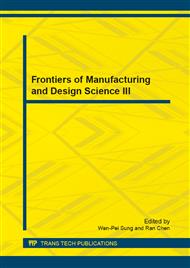[1]
Federico Montanarietal: Exploratory CFD Analyses of the Fluid Dynamics of a Water Cannon. AIAA Aerospace Sciences Meeting and Exhibit; (2005), p.1293.
DOI: 10.2514/6.2005-1293
Google Scholar
[2]
Renjun Zhan, Song Wang: Emulational Design of New-style Police Pulsed Anti-riots Water Cannon Based on Fluent. 5th European Symposium on Non-Lethal Weapons. Germany, May, (2009), Vol. 37, p.1–12.
Google Scholar
[3]
Song Wang, Renjun Zhan: Model experiment design of police anti-riots water cannon. Journal of Chang chun University of Technology(Natural Sciences Edition); (2009), Vol. 30, No. 2, p.173–177.
Google Scholar
[4]
Song Wang, Renjun Zhan: Model and 2-D Simulation Analysis of Launch Pipe of Police Pulsed Anti-riots Water Cannon. Journal of Air Force Engineering University(Natural Science Edition); (2009), No. 4.
Google Scholar
[5]
Renjun Zhan, Song Wang: Large Eddy Simulation of Nozzle Water-jet of Pulsed Anti-riots Water Cannon. Journal of Air Force Engineering University(Natural Science Edition); (2010), No. 3.
Google Scholar
[6]
G. A. Atanov: Optimization of The Action of a Pulsed Water Cannon With Power Drive. Fluid Dynamics;( 1993), Vol. 28, No. 6, p.872–875.
DOI: 10.1007/bf01049794
Google Scholar
[7]
G. A. Atanov: The Profile of The Nozzle of a Water Cannon Designed For Maximal Inflow Velocity. Journal of Mathematical Sciences; (1995), Vol. 77, No. 6, p.3537–3539.
DOI: 10.1007/bf02362721
Google Scholar
[8]
Mcilwains, Pollarda: Large eddy Simulation of the effects of mild swirl on the near field of a round free jet. Physics of Fluids; (2001), Vol. 42, No. 2, p.653–661.
DOI: 10.1063/1.1430734
Google Scholar
[9]
Xi Yu, Hongyuan Wei: Large Eddy Simulation for Large Eddy Simulation of Horizontal Pipe. Fluent conference paper (2005), p.562–569.
Google Scholar
[10]
Rong Tao, Liping Geng, Jingwei Zhou: Large eddy simulation of a precessing jet flow. 2004Journal of China Jiliang University; (2008), No. 6, p.124–128.
Google Scholar
[11]
Hirt CW, Nichols BD: Volume of fluid (VOF) method for the dynamics of free boundaries. J Comput Phys; (1981), Vol. 39, No. 1, p.201–205.
DOI: 10.1016/0021-9991(81)90145-5
Google Scholar
[12]
Zhaoshun Zhang, Guixiang Cui, Xiaochun Xu: The theory and application of large eddy simulation of turbulent flows. Beijing: Tsinghua University Press; (2008).
Google Scholar


